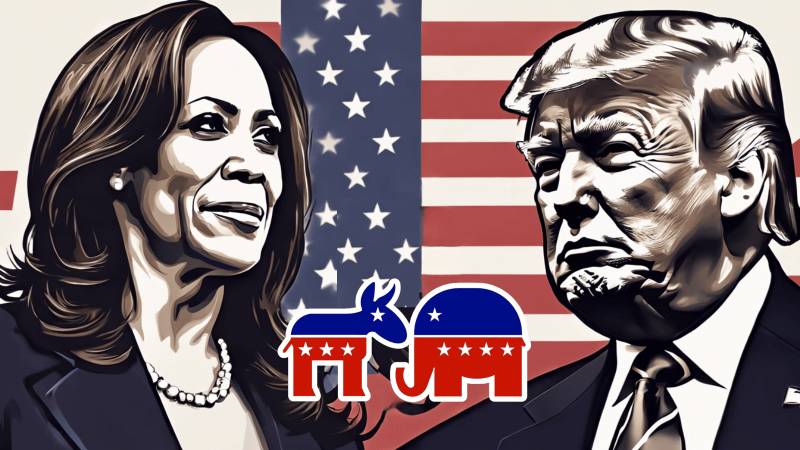
The ongoing calendar year was dubbed the year of elections, with many countries around the world going to the polls. From Pakistan, India, and Bangladesh in the subcontinent to Indonesia in Southeast Asia, Iran in the Middle East, the UK, France, and Russia in Europe, and the US in North America, elections were everywhere. Together, they had the potential to completely change the faces that dominate the world order.
Having already seen shocks and upsets in Pakistan, India, France, and the UK, all eyes have now turned towards perhaps the most significant elections of all: the US presidential elections.
With just months remaining until Americans go to the polls to pick a new president for the next four years, the presidential election campaign is under full swing. Former US president Donald Trump, having meandered through his legal difficulties and carrying the stigma of a conviction, has reappeared as a frontrunner for the Republican party.
US think tanks and political analysts have been closely monitoring Mr. Trump's triumphant moves toward the White House since the US Supreme Court ruled that the "[former] president has absolute immunity from criminal persecutions."
The Republicans widely applauded this decision as a win, while the Democratic representatives called it an authoritarian capture and an assault on American democracy.
Political divisions
In the past, American society has experienced a wide variety of political divisions and factionalism, which carried diverse ideologies. The Democratic, Republican, Libertarian, and Green parties were the major competitors in American electoral politics. Currently, the Republican and Democratic parties are the most influential players in presidential elections. The broad spectrum of the two parties is imagined as traditional/conservative and liberal, respectively. Thus, the general policies and political values of the two major parties are quite different—at times fundamentally so.
The Democratic party's key values emphasise democracy as a social responsibility. They believe in a powerful government that ensures welfare and equality for all. They have the propensity to level heavy taxes on high-income households. They believe they are strong advocates for religious freedom and other civil liberties while opposed to gun laws that allow Americans to openly bear arms.
On the other hand, Republicans have conservative values for American society and individuals. They believe in individual freedoms, enhanced funding for the military, private healthcare services, and a low degree of government interference. They value religious freedom but through a stringent lens. They defend marriage as a bond between a man and a woman and promote the right to display and preach religious scripture in public.
The candidate who receives the majority of electoral votes (at least 270 out of 538 -this allocation has been made on the 2020 census and is effective for the 2024 and 2028 presidential elections) wins the presidency
In their respective terms in power, both the Republicans and Democrats initiated programmes under the umbrella of parity values. For example, Democrat US President Barack Obama introduced the Affordable Care Act and signed bipartisan legislation for LGBT (lesbian, gay, bisexual, and trans) laws, but taxes remained an integral part of the debate.
In contrast, during his tenure, former US President Donald Trump took severe action by closing US borders along Mexico. He passed record-setting regulation cuts, replaced the North American Free Trade Agreement (NAFTA), invested US $2 trillion to completely rebuild the military, passed significant veteran affairs reforms, confirmed some 250 judges, lowered drug prices and protected the Medicare and Social Security programmes. Moreover, during the COVID-19 pandemic, he launched the greatest national mobilisation of Americans to counter it.
Voting in US elections
There is a need to understand the voting mechanism in the US. The US has two types of voting results: popular and electoral voting. Citizens vote for electors in the Electoral College, rather than directly for the president. Each state has a certain number of electors based on its representation in the US Congress. The candidate who receives the majority of electoral votes (at least 270 out of 538 -this allocation has been made on the 2020 census and is effective for the 2024 and 2028 presidential elections) wins the presidency.
If no candidate receives a majority, the House of Representatives selects the president. This process is established in Article II (Section 1) of the US Constitution. All 50 states, including the District of Columbia and Washington, D.C., have electors.
Impact of election outcomes
The US presidential elections will likely have grave impacts on global politics. Whosoever wins the November elections and becomes the new US president will determine the subsistence of wars, economic shifts and political instabilities in various parts of the world.
If the Democrats win, they will likely maintain a trans-Atlantic and trans-Pacific coalition to support Ukraine. Despite his aggressive stance towards Russia, the Biden administration has sustained its focus on China and the Indo-Pacific relationship strategy called "Invest-Align and Compete".
Should the Republicans win, any eventual government of theirs would face challenges in sustaining Trump's strict and moderate foreign policies like the Trans-Pacific Partnership, travel bans on foreign visitors, continuing trade under NAFTA and easing relationship with Russia and China for economic benefits and insignificant tilt for climate change.

